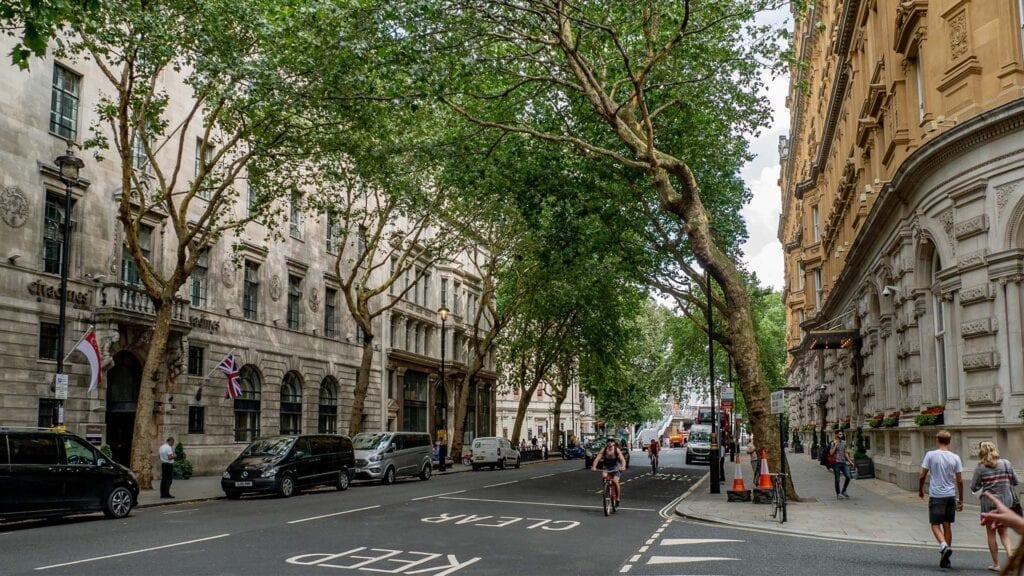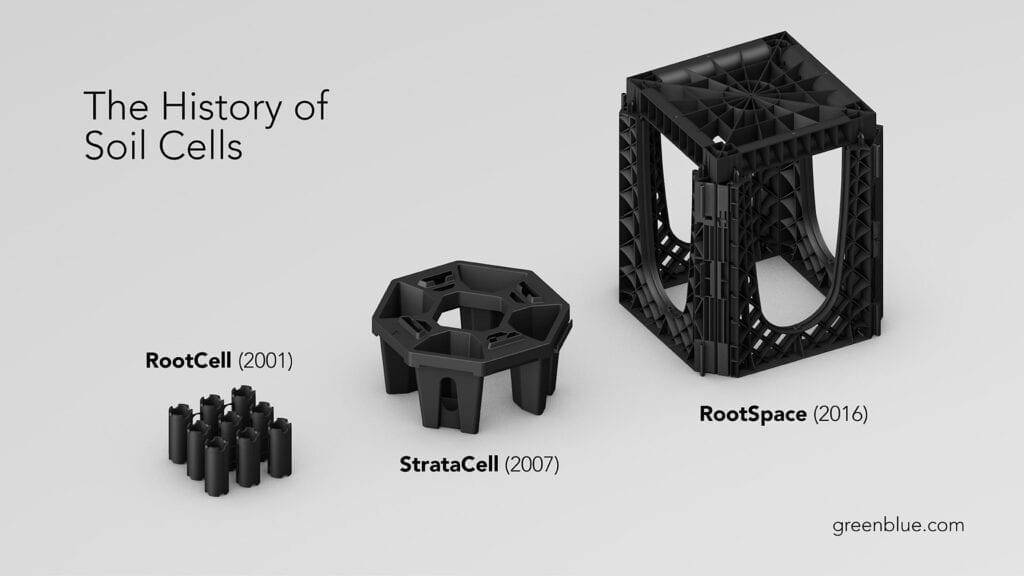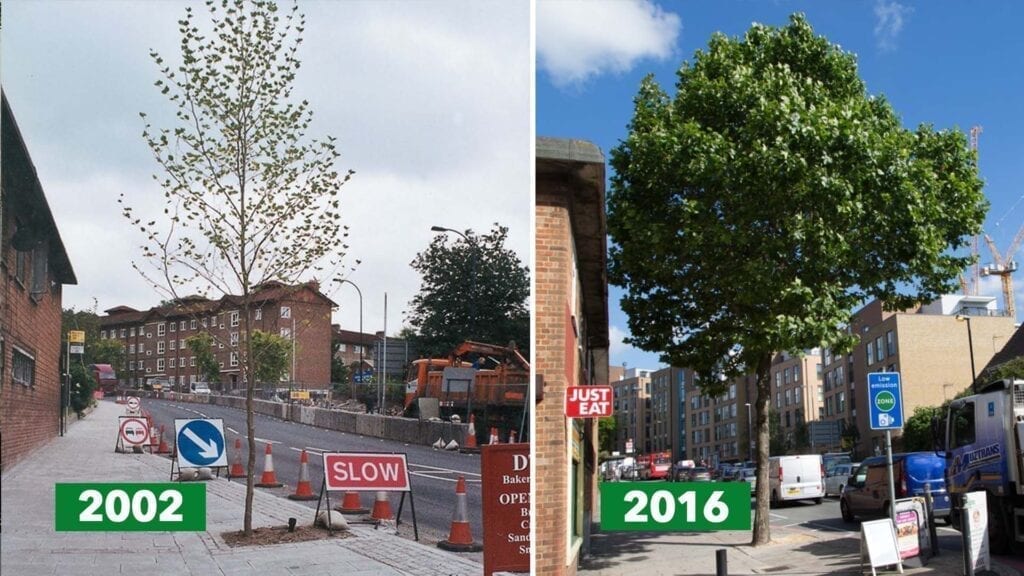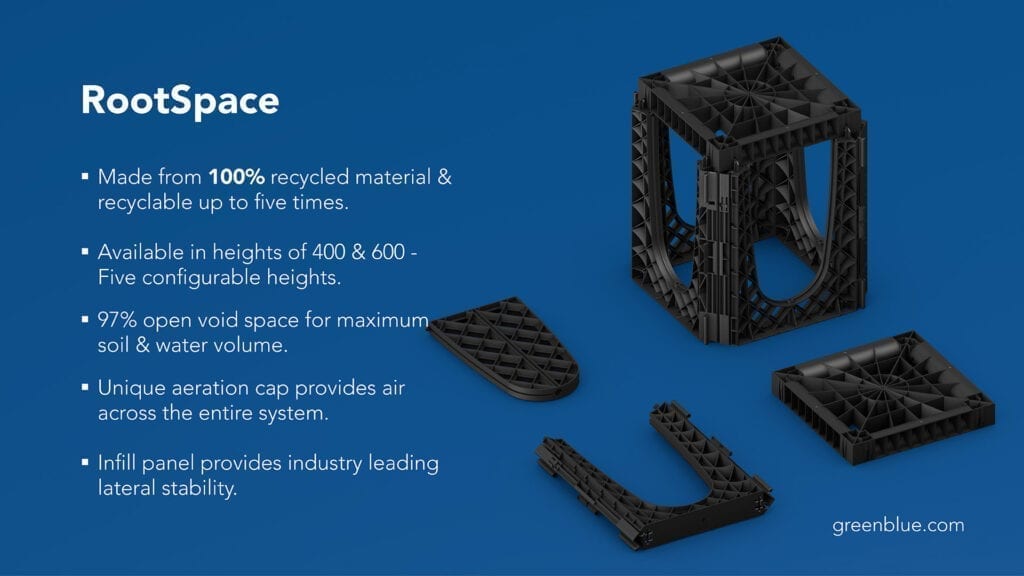With an influx of Tree Planting mediums in recent years, we take a look at the history, benefits and where they are best used.
The methodologies used in urban tree planting have been refined over the past twenty-five years, but the principles remain – room to grow above and below ground, uncompacted soil, air and water. Overall, the above-ground constraints are not an issue as trees will grow to a size related to the space available – if the tree can become established in the urban landscape.

For the past one hundred- and fifty-years arborists have been tried various systems and methods to give the tree a chance to attain species potential in longevity and size. In 1876 Northumberland Avenue was built, and it was considered important that the new London Plane trees being planted grew to maturity. The builders constructed a suspended pavement system giving the trees a huge volume of interconnected soil volume beneath the hard surface and adjacent to the highway – the first recorded uncompacted soil tree pit system.
Very little progress was made over the following one hundred years; in fact, the next methodology to be trialled was the structural soil system in Holland – often known as Amsterdam Sand. The concept used an aggregate mixed with organic content which could be compacted into a load-bearing substrate. This appeared to be a success and was hailed as the answer to all of the urban tree planting issues. However, when adapted and used elsewhere around the globe (often called tree sand, urban tree soil, CU soil, Stockholm mix), results have not shown the systems work reliably medium to long term unless the conditions that pertain in Holland are replaced below ground – tidal water tables replenishing nutrient daily, acceptance of hard surface heave and regular application of liquid fertiliser to the tree pits.

The breakthrough in achieving reliable repeatable urban tree planting results came in 2000 when Dean Bowie (CEO of GreenBlue Urban) experimented with a number of different ways to provide tree roots with the necessary soil elements– nutrient, structure, water and air – in the least possible space. The space issue is critical, as below our streets and paving there exist a plethora of other competing vital elements of infrastructure, so the smallest tree pit is always the easiest. Looking at research gathered from institutions all around the globe, Dean soon realised that it is not just the volume of the growing medium that mattered, but the quality of the soil; a lower nutrient proportion by volumes needs a larger tree pit. Therefore, the most efficient use of space means using the best “forest floor” quality of soil that can be found.
The problem with forest floor soil is that it is only healthy for as long as it is uncompacted. Higher organic volume soils quickly become anaerobic when compacted, creating zones from which tree roots cannot access nutrient or minerals. Therefore, it became obvious that to keep tree rooting zones effective for tree growth the soil must be uncompacted and aerated – the soil cell was born.

Initial trials used an existing GreenBlue Urban product, the Grass Ring ground stabilisation system, connected together to create individual cells 500mm x 500mm x 250mm high. Although these were not easy to fill with soil, these proved that trees prefer an uncompacted soil, and thrived in this product. Confident that there was a need for such a system, in 2001 GreenBlue Urban invested in the production of the first RootCell structure, manufactured from 100% recycled material, interlocking in all directions, which was far easier to install, and gave great lateral stability and the highest ever vertical soil cell loading – up to 90 tons/m² – never approached by any other soil cell.

The RootCell system took the world by storm and became highly specified across the globe. Many fine trees now thriving in our towns and cities are firmly rooted in these innovative cellular systems. But GreenBlue Urban wasn’t resting on their laurels; 2007 saw the release of the next leap forward in soil cells, the StrataCell. This octagonal stacking cellular system was cheaper to produce, cheaper to ship, quicker to install and easier to fill, and quickly became the world’s most specified and installed soil cell system. These became available in two capacities (30 tons/m² and 60 tons/m²) to enable these cells to be used below heavily trafficked locations, and well as a more cost-effective cell that can be used in less exacting situations.

GreenBlue never stops innovating; in 2015 RootSpace 600 was launched following consultation with the market. Customers wanted a cell system which was quicker to fill with soil, could work around larger utilities and finally, that was cheaper. This system carried forward all of the previous benefits from previous cell systems such as full interlocking between cells, manufactured in the UK from 100% recycled material (and recyclable up to 5 times) and high load-bearing capacity, and added to them the innovative aeration cap guaranteeing even air movement across the whole soil volume, provision of a structural side panel (greatly increasing the lateral load capacity reducing the need for concrete shuttering adjacent to heavily used highways) and the ability to fill the cells by machine rather than by hand. The RootSpace Generation 2 followed in 2018 with the inclusion of the RootSpace 400 to enable a wide range of depths to be constructed. In 2020 BBA approval was granted, an enviable stamp of international testing guaranteeing quality, and the only soil cell in the world to achieve this certification.

These unique advantages of the GreenBlue Urban RootSpace have made it a favourite product for urban tree planting for both specifiers and installers alike. From simple specification assistance, with free CAD and BIM models available online right through to free on-site support, The RootSpace is the only soil cell system which ticks every box. Reducing costs, reusing discarded plastics and supporting canopy growth for hundreds of years.

Yes, there are other “Engineered Solutions” available including crate and raft systems, however, the GreenBlue ArborSystem offers the full package of complementary products that can be configured to answer even the most challenging site and budgetary constraints and the only system fully manufactured in the UK available for immediate shipping and installation – contributing toward the carbon footprint!
– Call one of our advisors today to see how we can enable Green Infrastructure for all!
